Health Care Practice: Social Contentment and Health Determinants
VerifiedAdded on 2020/04/01
|8
|1412
|343
Report
AI Summary
This report delves into the multifaceted determinants of health, emphasizing the significance of social contentment and its profound impact on individual well-being. It examines the crucial role of healthy family relationships, highlighting how they contribute to happiness and reduce stress, thereby fostering stronger interactions and overall health. The report further explores the influence of healthy eating habits, regular exercise, and exposure to natural environments as vital factors in maintaining and enhancing health. It underscores the interplay between social support and individual health behaviors, emphasizing how positive social interactions can significantly influence health outcomes, particularly in mitigating mental and emotional issues. The report also provides an in-depth analysis of how social behaviors are influenced by family ties and upbringing, ultimately shaping an individual's perspectives on life and their ability to navigate health challenges. The document also provides references to support the claims.

Running Head: HEALTH CARE PRACTICE 1
Health Care Practice
Name
Institution
Health Care Practice
Name
Institution
Paraphrase This Document
Need a fresh take? Get an instant paraphrase of this document with our AI Paraphraser
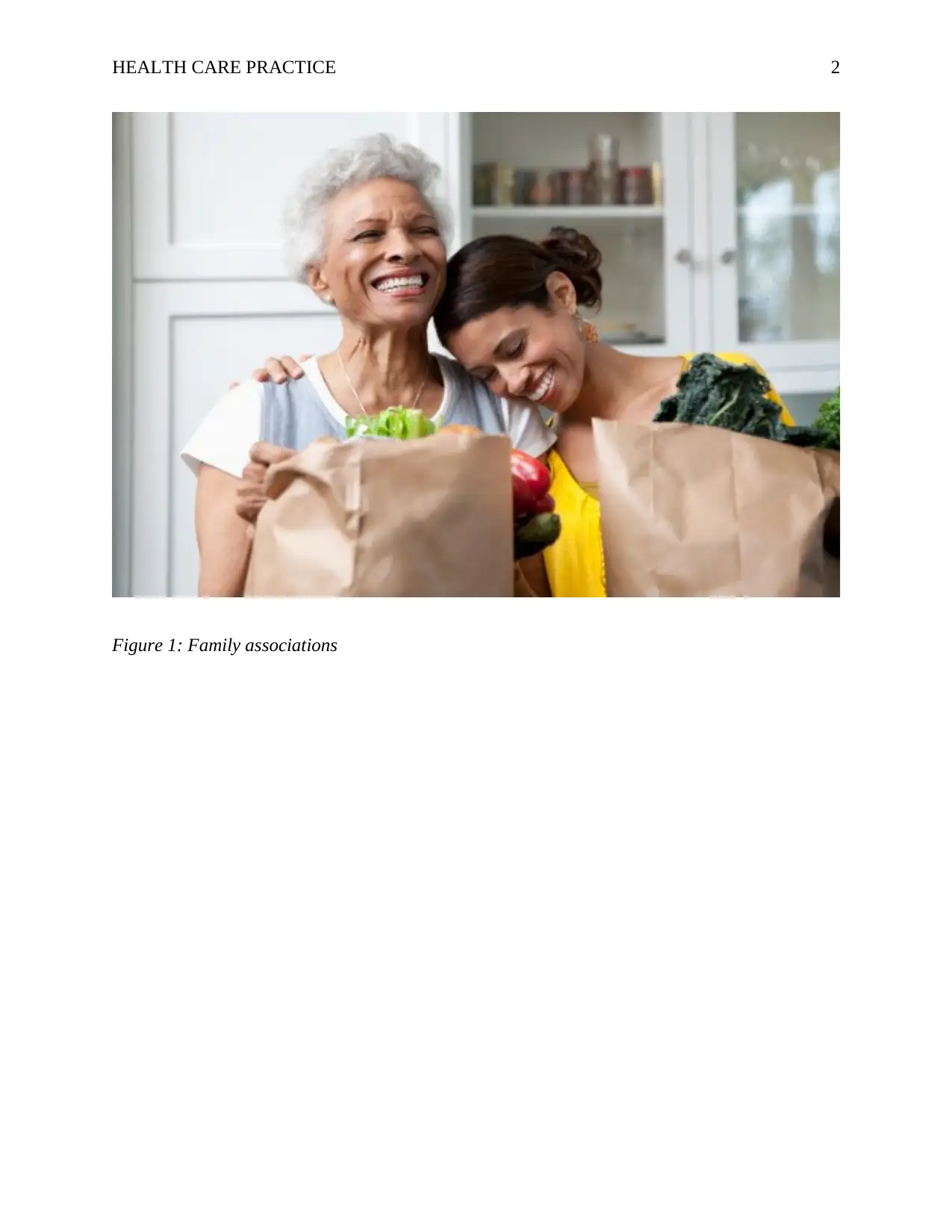
HEALTH CARE PRACTICE 2
Figure 1: Family associations
Figure 1: Family associations
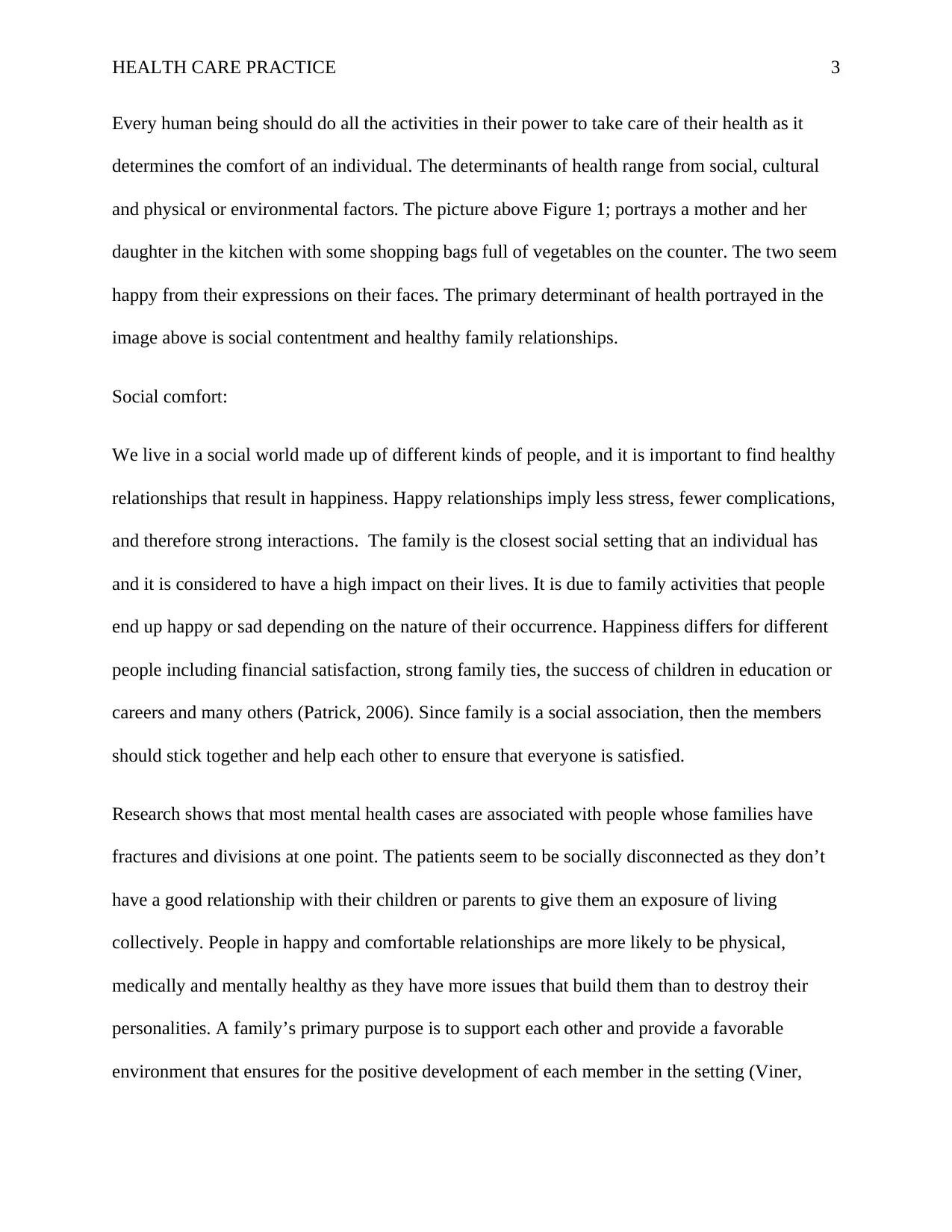
HEALTH CARE PRACTICE 3
Every human being should do all the activities in their power to take care of their health as it
determines the comfort of an individual. The determinants of health range from social, cultural
and physical or environmental factors. The picture above Figure 1; portrays a mother and her
daughter in the kitchen with some shopping bags full of vegetables on the counter. The two seem
happy from their expressions on their faces. The primary determinant of health portrayed in the
image above is social contentment and healthy family relationships.
Social comfort:
We live in a social world made up of different kinds of people, and it is important to find healthy
relationships that result in happiness. Happy relationships imply less stress, fewer complications,
and therefore strong interactions. The family is the closest social setting that an individual has
and it is considered to have a high impact on their lives. It is due to family activities that people
end up happy or sad depending on the nature of their occurrence. Happiness differs for different
people including financial satisfaction, strong family ties, the success of children in education or
careers and many others (Patrick, 2006). Since family is a social association, then the members
should stick together and help each other to ensure that everyone is satisfied.
Research shows that most mental health cases are associated with people whose families have
fractures and divisions at one point. The patients seem to be socially disconnected as they don’t
have a good relationship with their children or parents to give them an exposure of living
collectively. People in happy and comfortable relationships are more likely to be physical,
medically and mentally healthy as they have more issues that build them than to destroy their
personalities. A family’s primary purpose is to support each other and provide a favorable
environment that ensures for the positive development of each member in the setting (Viner,
Every human being should do all the activities in their power to take care of their health as it
determines the comfort of an individual. The determinants of health range from social, cultural
and physical or environmental factors. The picture above Figure 1; portrays a mother and her
daughter in the kitchen with some shopping bags full of vegetables on the counter. The two seem
happy from their expressions on their faces. The primary determinant of health portrayed in the
image above is social contentment and healthy family relationships.
Social comfort:
We live in a social world made up of different kinds of people, and it is important to find healthy
relationships that result in happiness. Happy relationships imply less stress, fewer complications,
and therefore strong interactions. The family is the closest social setting that an individual has
and it is considered to have a high impact on their lives. It is due to family activities that people
end up happy or sad depending on the nature of their occurrence. Happiness differs for different
people including financial satisfaction, strong family ties, the success of children in education or
careers and many others (Patrick, 2006). Since family is a social association, then the members
should stick together and help each other to ensure that everyone is satisfied.
Research shows that most mental health cases are associated with people whose families have
fractures and divisions at one point. The patients seem to be socially disconnected as they don’t
have a good relationship with their children or parents to give them an exposure of living
collectively. People in happy and comfortable relationships are more likely to be physical,
medically and mentally healthy as they have more issues that build them than to destroy their
personalities. A family’s primary purpose is to support each other and provide a favorable
environment that ensures for the positive development of each member in the setting (Viner,
⊘ This is a preview!⊘
Do you want full access?
Subscribe today to unlock all pages.

Trusted by 1+ million students worldwide
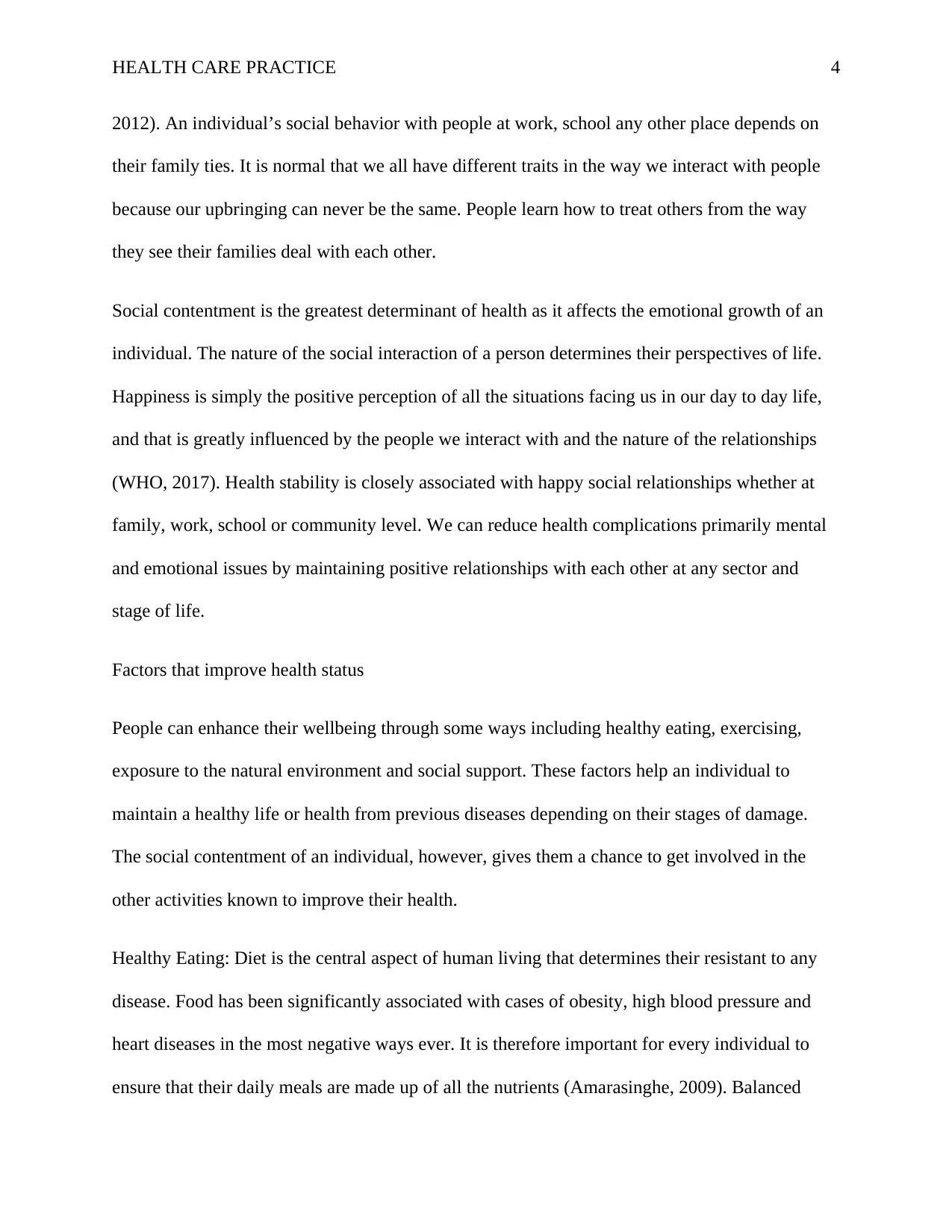
HEALTH CARE PRACTICE 4
2012). An individual’s social behavior with people at work, school any other place depends on
their family ties. It is normal that we all have different traits in the way we interact with people
because our upbringing can never be the same. People learn how to treat others from the way
they see their families deal with each other.
Social contentment is the greatest determinant of health as it affects the emotional growth of an
individual. The nature of the social interaction of a person determines their perspectives of life.
Happiness is simply the positive perception of all the situations facing us in our day to day life,
and that is greatly influenced by the people we interact with and the nature of the relationships
(WHO, 2017). Health stability is closely associated with happy social relationships whether at
family, work, school or community level. We can reduce health complications primarily mental
and emotional issues by maintaining positive relationships with each other at any sector and
stage of life.
Factors that improve health status
People can enhance their wellbeing through some ways including healthy eating, exercising,
exposure to the natural environment and social support. These factors help an individual to
maintain a healthy life or health from previous diseases depending on their stages of damage.
The social contentment of an individual, however, gives them a chance to get involved in the
other activities known to improve their health.
Healthy Eating: Diet is the central aspect of human living that determines their resistant to any
disease. Food has been significantly associated with cases of obesity, high blood pressure and
heart diseases in the most negative ways ever. It is therefore important for every individual to
ensure that their daily meals are made up of all the nutrients (Amarasinghe, 2009). Balanced
2012). An individual’s social behavior with people at work, school any other place depends on
their family ties. It is normal that we all have different traits in the way we interact with people
because our upbringing can never be the same. People learn how to treat others from the way
they see their families deal with each other.
Social contentment is the greatest determinant of health as it affects the emotional growth of an
individual. The nature of the social interaction of a person determines their perspectives of life.
Happiness is simply the positive perception of all the situations facing us in our day to day life,
and that is greatly influenced by the people we interact with and the nature of the relationships
(WHO, 2017). Health stability is closely associated with happy social relationships whether at
family, work, school or community level. We can reduce health complications primarily mental
and emotional issues by maintaining positive relationships with each other at any sector and
stage of life.
Factors that improve health status
People can enhance their wellbeing through some ways including healthy eating, exercising,
exposure to the natural environment and social support. These factors help an individual to
maintain a healthy life or health from previous diseases depending on their stages of damage.
The social contentment of an individual, however, gives them a chance to get involved in the
other activities known to improve their health.
Healthy Eating: Diet is the central aspect of human living that determines their resistant to any
disease. Food has been significantly associated with cases of obesity, high blood pressure and
heart diseases in the most negative ways ever. It is therefore important for every individual to
ensure that their daily meals are made up of all the nutrients (Amarasinghe, 2009). Balanced
Paraphrase This Document
Need a fresh take? Get an instant paraphrase of this document with our AI Paraphraser
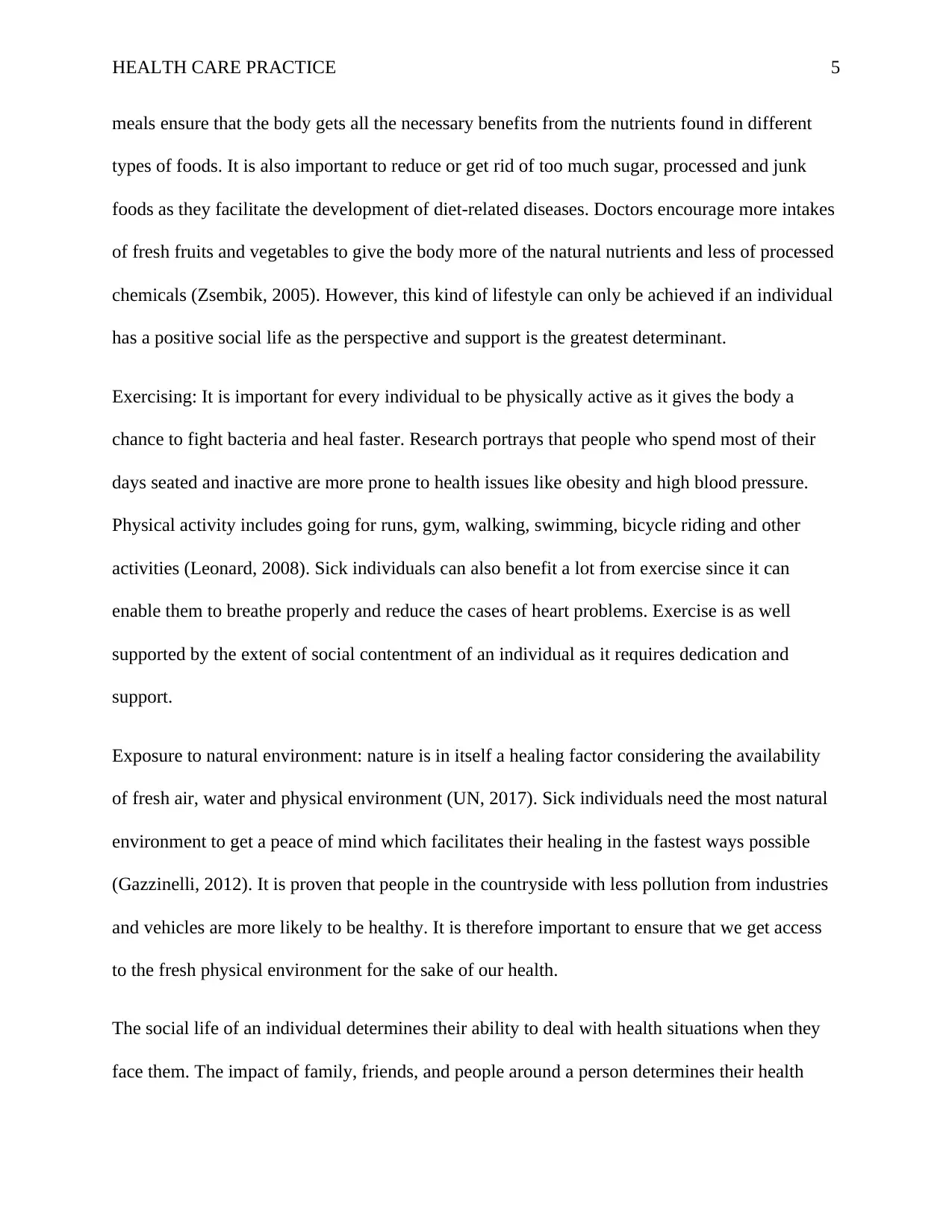
HEALTH CARE PRACTICE 5
meals ensure that the body gets all the necessary benefits from the nutrients found in different
types of foods. It is also important to reduce or get rid of too much sugar, processed and junk
foods as they facilitate the development of diet-related diseases. Doctors encourage more intakes
of fresh fruits and vegetables to give the body more of the natural nutrients and less of processed
chemicals (Zsembik, 2005). However, this kind of lifestyle can only be achieved if an individual
has a positive social life as the perspective and support is the greatest determinant.
Exercising: It is important for every individual to be physically active as it gives the body a
chance to fight bacteria and heal faster. Research portrays that people who spend most of their
days seated and inactive are more prone to health issues like obesity and high blood pressure.
Physical activity includes going for runs, gym, walking, swimming, bicycle riding and other
activities (Leonard, 2008). Sick individuals can also benefit a lot from exercise since it can
enable them to breathe properly and reduce the cases of heart problems. Exercise is as well
supported by the extent of social contentment of an individual as it requires dedication and
support.
Exposure to natural environment: nature is in itself a healing factor considering the availability
of fresh air, water and physical environment (UN, 2017). Sick individuals need the most natural
environment to get a peace of mind which facilitates their healing in the fastest ways possible
(Gazzinelli, 2012). It is proven that people in the countryside with less pollution from industries
and vehicles are more likely to be healthy. It is therefore important to ensure that we get access
to the fresh physical environment for the sake of our health.
The social life of an individual determines their ability to deal with health situations when they
face them. The impact of family, friends, and people around a person determines their health
meals ensure that the body gets all the necessary benefits from the nutrients found in different
types of foods. It is also important to reduce or get rid of too much sugar, processed and junk
foods as they facilitate the development of diet-related diseases. Doctors encourage more intakes
of fresh fruits and vegetables to give the body more of the natural nutrients and less of processed
chemicals (Zsembik, 2005). However, this kind of lifestyle can only be achieved if an individual
has a positive social life as the perspective and support is the greatest determinant.
Exercising: It is important for every individual to be physically active as it gives the body a
chance to fight bacteria and heal faster. Research portrays that people who spend most of their
days seated and inactive are more prone to health issues like obesity and high blood pressure.
Physical activity includes going for runs, gym, walking, swimming, bicycle riding and other
activities (Leonard, 2008). Sick individuals can also benefit a lot from exercise since it can
enable them to breathe properly and reduce the cases of heart problems. Exercise is as well
supported by the extent of social contentment of an individual as it requires dedication and
support.
Exposure to natural environment: nature is in itself a healing factor considering the availability
of fresh air, water and physical environment (UN, 2017). Sick individuals need the most natural
environment to get a peace of mind which facilitates their healing in the fastest ways possible
(Gazzinelli, 2012). It is proven that people in the countryside with less pollution from industries
and vehicles are more likely to be healthy. It is therefore important to ensure that we get access
to the fresh physical environment for the sake of our health.
The social life of an individual determines their ability to deal with health situations when they
face them. The impact of family, friends, and people around a person determines their health
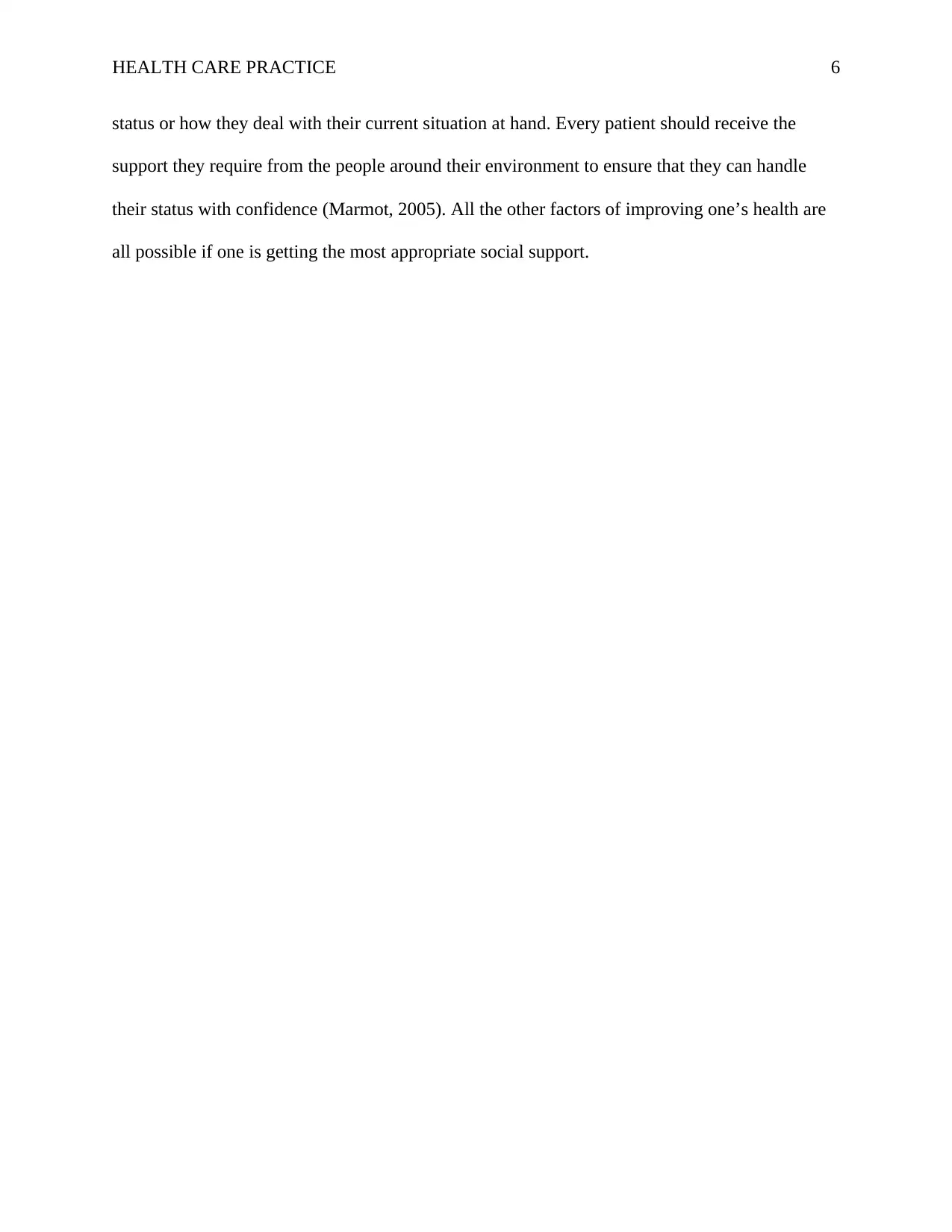
HEALTH CARE PRACTICE 6
status or how they deal with their current situation at hand. Every patient should receive the
support they require from the people around their environment to ensure that they can handle
their status with confidence (Marmot, 2005). All the other factors of improving one’s health are
all possible if one is getting the most appropriate social support.
status or how they deal with their current situation at hand. Every patient should receive the
support they require from the people around their environment to ensure that they can handle
their status with confidence (Marmot, 2005). All the other factors of improving one’s health are
all possible if one is getting the most appropriate social support.
⊘ This is a preview!⊘
Do you want full access?
Subscribe today to unlock all pages.

Trusted by 1+ million students worldwide
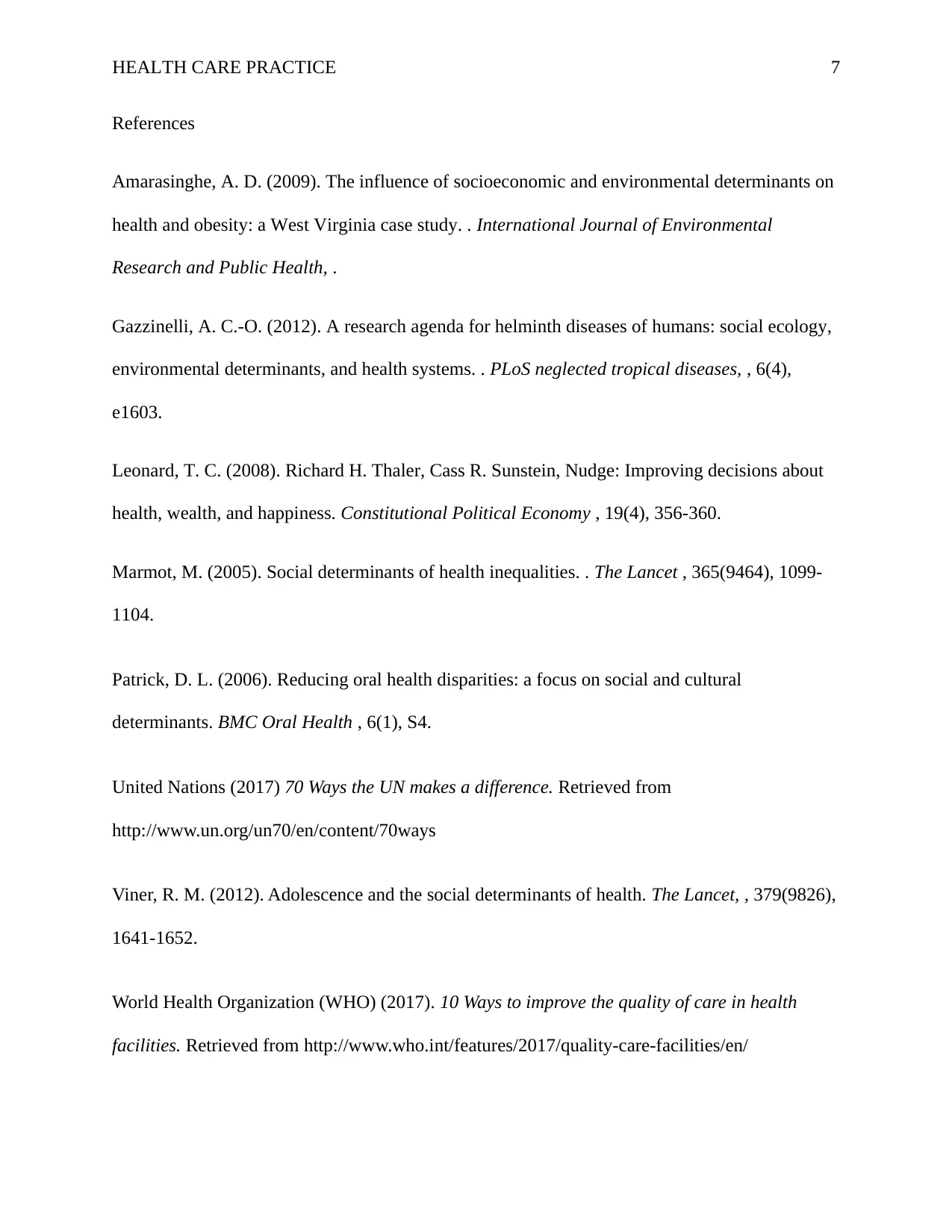
HEALTH CARE PRACTICE 7
References
Amarasinghe, A. D. (2009). The influence of socioeconomic and environmental determinants on
health and obesity: a West Virginia case study. . International Journal of Environmental
Research and Public Health, .
Gazzinelli, A. C.-O. (2012). A research agenda for helminth diseases of humans: social ecology,
environmental determinants, and health systems. . PLoS neglected tropical diseases, , 6(4),
e1603.
Leonard, T. C. (2008). Richard H. Thaler, Cass R. Sunstein, Nudge: Improving decisions about
health, wealth, and happiness. Constitutional Political Economy , 19(4), 356-360.
Marmot, M. (2005). Social determinants of health inequalities. . The Lancet , 365(9464), 1099-
1104.
Patrick, D. L. (2006). Reducing oral health disparities: a focus on social and cultural
determinants. BMC Oral Health , 6(1), S4.
United Nations (2017) 70 Ways the UN makes a difference. Retrieved from
http://www.un.org/un70/en/content/70ways
Viner, R. M. (2012). Adolescence and the social determinants of health. The Lancet, , 379(9826),
1641-1652.
World Health Organization (WHO) (2017). 10 Ways to improve the quality of care in health
facilities. Retrieved from http://www.who.int/features/2017/quality-care-facilities/en/
References
Amarasinghe, A. D. (2009). The influence of socioeconomic and environmental determinants on
health and obesity: a West Virginia case study. . International Journal of Environmental
Research and Public Health, .
Gazzinelli, A. C.-O. (2012). A research agenda for helminth diseases of humans: social ecology,
environmental determinants, and health systems. . PLoS neglected tropical diseases, , 6(4),
e1603.
Leonard, T. C. (2008). Richard H. Thaler, Cass R. Sunstein, Nudge: Improving decisions about
health, wealth, and happiness. Constitutional Political Economy , 19(4), 356-360.
Marmot, M. (2005). Social determinants of health inequalities. . The Lancet , 365(9464), 1099-
1104.
Patrick, D. L. (2006). Reducing oral health disparities: a focus on social and cultural
determinants. BMC Oral Health , 6(1), S4.
United Nations (2017) 70 Ways the UN makes a difference. Retrieved from
http://www.un.org/un70/en/content/70ways
Viner, R. M. (2012). Adolescence and the social determinants of health. The Lancet, , 379(9826),
1641-1652.
World Health Organization (WHO) (2017). 10 Ways to improve the quality of care in health
facilities. Retrieved from http://www.who.int/features/2017/quality-care-facilities/en/
Paraphrase This Document
Need a fresh take? Get an instant paraphrase of this document with our AI Paraphraser
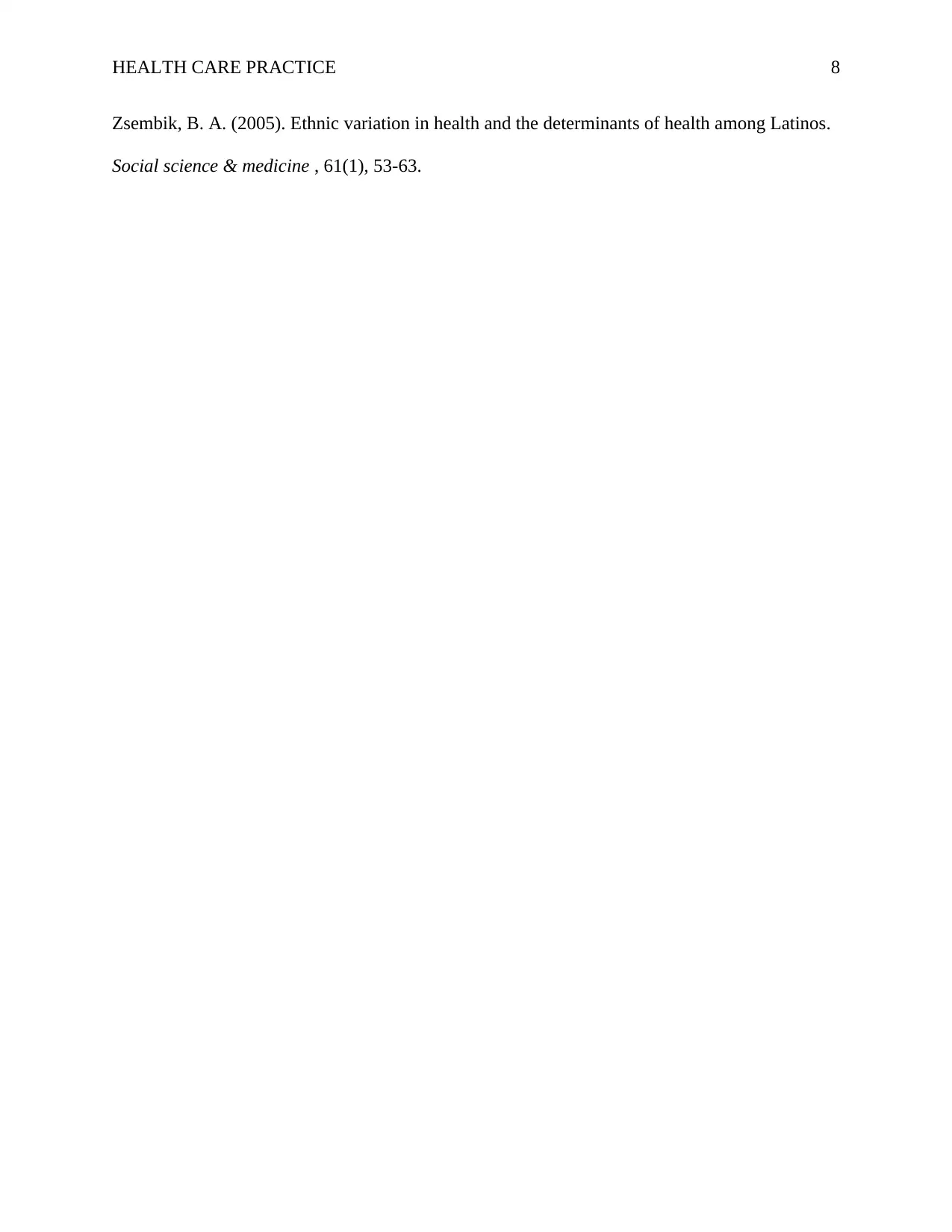
HEALTH CARE PRACTICE 8
Zsembik, B. A. (2005). Ethnic variation in health and the determinants of health among Latinos.
Social science & medicine , 61(1), 53-63.
Zsembik, B. A. (2005). Ethnic variation in health and the determinants of health among Latinos.
Social science & medicine , 61(1), 53-63.
1 out of 8
Related Documents
Your All-in-One AI-Powered Toolkit for Academic Success.
+13062052269
info@desklib.com
Available 24*7 on WhatsApp / Email
![[object Object]](/_next/static/media/star-bottom.7253800d.svg)
Unlock your academic potential
Copyright © 2020–2025 A2Z Services. All Rights Reserved. Developed and managed by ZUCOL.





